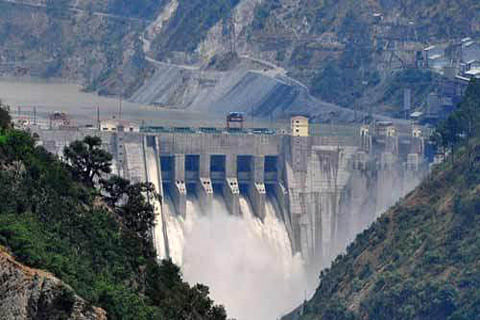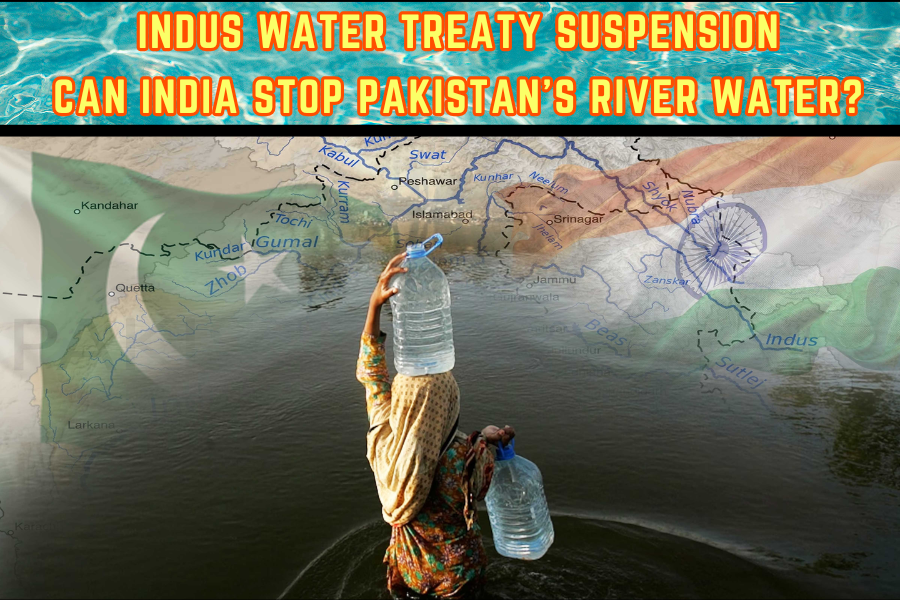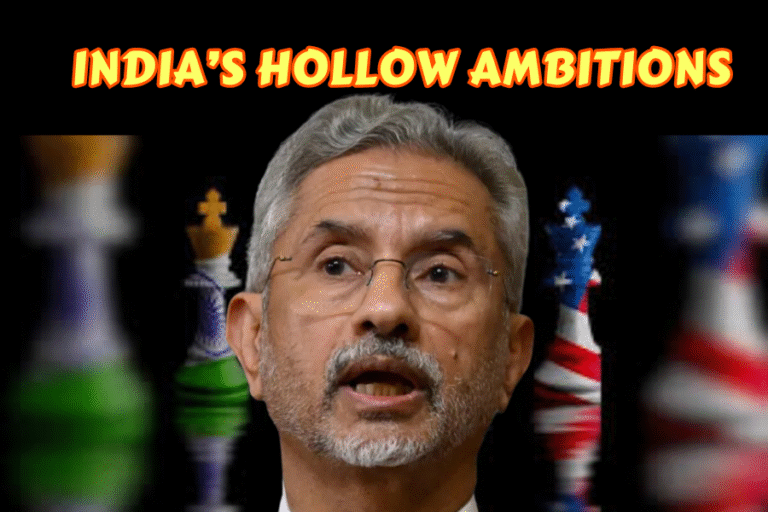(Ayesha Mohsin)
In Saadat Hasan Manto’s 1951 short story Yazid, a Pakistani villager laments India’s ability to choke the rivers flowing into Pakistan, a fear that resonates chillingly in 2025. On 22 April 2025, the Pahalgam attack in Indian Occupied Kashmir, which claimed 26 civilian lives, prompted India to suspend the Indus Waters Treaty (IWT), accusing Pakistan of sponsoring terrorism. This unprecedented move, halting data sharing, commission meetings, and initiating water-diversion projects, has reignited a decades-old question: Can India realistically block Pakistan’s river water, and could this act of hydro-diplomacy escalate into a full-scale conflict between two nuclear-armed neighbours? India’s actions represent a dangerous overreach, threatening Pakistan’s lifeline while risking regional stability. This article examines the feasibility of India’s water weaponization, Pakistan’s vulnerabilities, and the potential for a new war, drawing on technical, legal, and geopolitical insights.
I. The Indus Waters Treaty: A Fragile Lifeline
Signed in 1960 under World Bank mediation, the Indus Waters Treaty was a landmark agreement to equitably divide the Indus River Basin’s six rivers post-Partition. India gained control over the Eastern rivers—Ravi, Sutlej, and Beas—while Pakistan was allocated the Western rivers—Indus, Jhelum, and Chenab—which supply 80% of its water (135 million acre-feet annually). India was permitted limited “run-of-the-river” hydroelectric projects on Western rivers, with strict design constraints to ensure uninterrupted flow to Pakistan. The treaty’s resilience through wars (1965, 1971, 1999) and crises (Uri 2016, Pulwama 2019) made it a cornerstone of uneasy coexistence. Yet, India’s repeated threats to renegotiate or suspend the IWT—voiced in 2016, 2019, 2023, and 2024—exposed its fragility, culminating in the 2025 suspension.
II. The 2025 Catalyst: Pahalgam and India’s Provocation
The Pahalgam attack on 22 April 2025, where gunmen killed 26 civilians in Baisaran Valley, provided India the pretext to escalate tensions. Prime Minister Narendra Modi and External Affairs Minister S. Jaishankar swiftly blamed Pakistan for backing The Resistance Front (TRF), without verifiable evidence. India’s response was draconian: suspending the IWT, halting hydrological data sharing, closing the Attari border, and banning 16 Pakistani YouTube channels. Infrastructure moves followed, including flushing reservoirs at Baglihar and Salal dams and expanding the Ranbir canal to divert water from the Chenab. Pakistan condemned the suspension as an “act of war,” rejecting unilateral termination as illegal under international law and threatening to suspend the 1972 Simla Agreement while seeking recourse through the International Court of Justice (ICJ).
III. Can India Stop Pakistan’s Water? A Technical Assessment
India’s ability to block Pakistan’s water hinges on its infrastructure and strategic intent, but technical limitations constrain immediate impact.
a. Current Capabilities
India’s run-of-the-river dams—Kishanganga, Baglihar, and Ratle—are designed for power generation, not large-scale storage. In May 2025, India’s flushing of the Baglihar dam reduced Chenab flows by 90% for 48 hours, disrupting Pakistan’s irrigation temporarily. However, these dams lack the capacity to sustain long-term blockages. Monsoon seasons, with high river flows, overwhelm India’s storage infrastructure, rendering permanent diversion unfeasible without flooding Indian territory.

b. Long-Term Projects
India is pursuing ambitious projects to maximize water control:
- Ranbir Canal Expansion: Extending to 120km, it aims to divert 150 cubic meters/second from the Chenab, reducing Pakistan’s share.
- New Dams: The Ujh and Shahpurkandi projects on Eastern rivers could redirect surplus water, cutting flows to Pakistan’s border canals.
- Construction Timelines: These projects require 4–20 years, limiting immediate threats but signaling long-term intent.

c. Constraints
High-flow monsoons (June–September) account for 70% of the Indus Basin’s water, making sustained blockages challenging. Silt flushing without coordination risks downstream damage in Pakistan but could backfire, flooding Indian Punjab. Experts estimate that Pakistan’s 80% share of Western rivers remains largely secure in the short term, though incremental reductions are possible.
IV. Pakistan’s Vulnerabilities: The Stakes of Water Weaponization
The Indus Basin is Pakistan’s economic and ecological lifeline, making India’s actions a profound threat.
a. Economic Dependence
The Western rivers irrigate 16 million hectares (80% of Pakistan’s farmland), supporting 24% of GDP and 37% of employment. Hydropower from these rivers generates one-fifth of Pakistan’s electricity, critical for industrial and domestic needs. Even temporary disruptions, like the 2025 Baglihar flushing, caused crop losses in Punjab and Sindh, highlighting Pakistan’s reliance.
b. Dry Season Risks
During low-flow periods (November–March), reduced water could devastate agriculture, drinking water supplies, and hydropower. A 20% reduction in Chenab flows could cut wheat yields by 15%, impacting 10 million farmers. Energy shortages would exacerbate load-shedding, already a chronic issue.
c. Inter-Provincial Tensions
Pakistan’s internal water disputes, particularly Sindh’s protests against Punjab’s Cholistan canal, could intensify if India restricts flows. Reduced water to Sindh’s Indus Delta threatens rice production and urban water supply in Karachi.
d. Environmental Impact
The Indus Delta, already shrinking due to upstream diversions, faces further degradation. Salinity intrusion and mangrove loss threaten coastal fisheries, affecting 1.2 million livelihoods. Climate change, with melting Himalayan glaciers and erratic monsoons, compounds these risks.
V. Legal and International Dimensions
a. IWT Framework
The IWT lacks provisions for unilateral suspension; amendments require mutual consent. Its dispute resolution mechanism—Indus Commissioners, neutral experts, and arbitration courts—offers Pakistan avenues for redress. However, India’s refusal to engage in commission meetings post-2025 undermines this framework. Pakistan could pursue legal action through the ICJ or Permanent Court of Arbitration (PCA), though enforcement remains challenging due to India’s veto power in international forums.
b. International Law
As an upper riparian state, India is bound by customary international law, including the 1997 UN Watercourses Convention, to avoid causing significant harm to lower riparian states like Pakistan. Unilateral water diversion violates these principles, risking global condemnation.
c. Global Reactions
The World Bank, a treaty facilitator, has remained neutral, limiting its role. China and Russia, key allies of Pakistan, have supported its stance within the Shanghai Cooperation Organisation (SCO), while the G7 and QUAD have avoided endorsing India’s suspension. India’s actions, coupled with its 2023–2025 transnational assassination scandals, erode its image as a “rules-based” power, especially as a downstream state facing China’s Brahmaputra dams.
VI. Geopolitical Implications: A New Flashpoint?
a. Nuclear Risk
With both nations possessing nuclear arsenals, water weaponization is a high-stakes gamble. Pakistan’s military leadership, led by Field Marshal Asim Munir, has warned of a “full spectrum” response to India’s actions, signaling potential escalation beyond conventional conflict. The 2025 Operation Bunyan-un-Marsoos, which downed six Indian jets, underscores Pakistan’s readiness to counter aggression.
b. Regional Dynamics
India’s upstream advantage mirrors China’s control over the Brahmaputra, where Beijing’s dams (e.g., Medog county) threaten India’s Northeast. This duality exposes India’s hypocrisy as it protests Chinese hydro-hegemony while pursuing similar tactics against Pakistan. Pakistan’s alliances with China (via CPEC and SACA) and Turkey bolster its diplomatic leverage, as seen in the 2023 Azerbaijan drone deal and 2024 Malaysian contract.
c. Escalation Pathways
India’s long-term projects, if completed, could reduce Pakistan’s water by 10–15% by 2035, particularly during dry seasons. Pakistan’s retaliatory options—suspending the Simla Agreement, closing airspace, or escalating militarily—could spiral into broader conflict. Social media posts on X highlight Pakistan’s growing drone capabilities (Bayraktar TB2, Wing Loong II) as a countermeasure to India’s conventional edge.
d. Diplomatic Hope
Analysts urge restoring the IWT through dialogue, potentially mediated by the UN or neutral states like Turkey. Pakistan’s call for an impartial Pahalgam investigation, backed by SCO partners, offers a pathway to de-escalation, though India’s refusal to engage remains a hurdle.
VII. Water as a Weapon: Historical and Regional Context
India’s 1948 water cutoff post-Partition, halting Ravi flows for weeks, set a precedent for hydro-coercion. The 2016 “blood and water” rhetoric post-Uri and 2025’s IWT suspension reflect a recurring strategy under the Doval Doctrine. Meanwhile, China’s upstream dams on the Indus and Brahmaputra complicate India’s position, exposing its vulnerability as a lower riparian state. Climate change, reducing Indus flows by 8% since 2000 due to glacial melt, intensifies competition, making cooperation imperative.
VIII. Conclusion: Averting a Water War
India’s suspension of the Indus Waters Treaty is a symbolic flex with limited immediate impact, as its infrastructure cannot fully block Pakistan’s Western rivers. Yet, long-term projects like canal expansions and new dams threaten Pakistan’s agriculture, energy, and ecological stability, risking internal strife and nuclear escalation. The IWT’s legal framework and international law constrain India’s actions, but its refusal to engage diplomatically isolates it, especially as Pakistan strengthens ties with China, Turkey, and Azerbaijan. Diplomacy, potentially through UN mediation, is critical to restore the treaty and prevent water from becoming a casus belli. As Manto warned, rivers are not drains to be closed at will—they are lifelines for millions, demanding cooperation over conflict in a volatile region.
_________________________________________________________________________________
Sources:
Suspending the Indus Waters Treaty: What it Means and Why it Matters
Indus Waters Treaty – Wikipedia
India-Pakistan water treaty remains suspended despite ceasefire
India’s Indus Waters Treaty Suspension: What Happens Next?
India suspends Indus Water Treaty with Pakistan immediately
As Bilawal Bhutto Threatens War Over Indus Pact, How India Move Impacts Pak
What India’s Indus Waters Treaty suspension means for Pakistan
One month since Indus Waters Treaty suspension – India Today
Will India suspending Indus Waters Treaty affect Pakistan? – BBC
At UN, Pakistan accuses India of weaponizing water as their delegates clash
How India’s Indus Water Treaty suspension will affect Pakistan
India’s Indus Treaty Suspension Leads To Water Crisis In Pakistan







